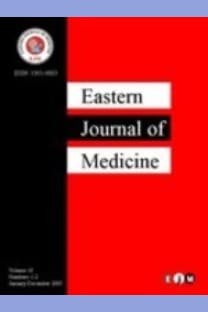Evaluation of Patients With Uterine Perforation After Intrauterine Device Placement and Determination of Risk Factors: A Retrospective Case-Control Study
Evaluation of Patients With Uterine Perforation After Intrauterine Device Placement and Determination of Risk Factors: A Retrospective Case-Control Study
___
- United Nations. World contraceptive use 2011. http://www.un.org/esa/population/publicati ons/contraceptive2011/contraceptive2011.ht m (Accessed on March 20, 2014).
- Buhling KJ, Zite NB, Lotke P, Black K, INTRA Writing Group. Worldwide use of intrauterine contraception: A review. Contraception 2014; 89: 162- 173.
- ACOG Committee Opinion No. 735: adolescents and long-acting reversible contraception: implants and intrauterine devices. Obstet Gynecol 2018; 131: 130.
- Boortz HE, Margolis DJA, Ragavendra N, Patel MK, Kadell BM. Migration of Intrauter ine Devices: Radiologic Findings and Implica tions for Patient Care. RadioGraphics 2012; 32: 335- 352.
- Mirena [package insert]. Whippany, NJ, Bayer, 2017.
- Skyla [package insert]. Whippany, NJ, Bayer, 2018.
- Liletta [package insert]. Irvine, CA, Allergan, 2018.
- Kyleena [package insert]. Whippany, NJ, Bayer, 2018.
- Adeyemi-Fowode OA, Bercaw-Pratt JL. Intrauterine Devices: Effective Contraception with Noncontraceptive Benefits for Adolescents. J Pediatr Adolesc Gynecol 2019; 32: 2- 6.
- Nowitzki KM, Hoimes ML, Chen B, Zheng LZ, Kim YH. Ultrasonography of intrauterine devices. Ultrasonography 2015; 34: 183- 194.
- Uçar MG, Şanlıkan F, Ilhan TT, Göçmen A, Çelik Ç. Management of intra-abdominally translocated contraceptive devices, is surgery the only way to treat this problem? J Obstet Gynaecol 2017; 37: 480-486.
- Agacayak E, Tunc SY, Icen MS, et al. Evaluation of predisposing factors, diagnostic and treatment methods in patients with translocation of intrauterine devices. J. Obstet. Gynaecol Res 2015; 41: 735- 741.
- Soydinç HE, Evsen MS, Çaça F, Sak ME, Taner MZ, Sak S. Translocated intrauterine contraceptive device: experiences of two medical centers with risk factors and the need for surgical treatment. J Reprod Med 2013; 58: 234- 240.
- Kaislasuo J, Suhonen S, Gissler M, Lahteenmaki P, Heikinheimo O. Intrauterine contraception: incidence and factors associated with uterine perforation—a population-based study. Hum Reprod 2012; 27: 2658- 2663.
- Barnett C, Moehner S, Minh TD, Heinemann K. Perforation risk and intra-uterine devices: results of the EURAS-IUD 5-year extension study. Eur J Contracept Reprod Health Care 2017; 22: 424-428.
- Lohr PA, Lyus R, Prager S. Use of intrauterine devices in nulliparous women. Contraception 2017; 95: 529– 537.
- Kaleem A, Zaman BS, Nasir M, Hassan A. Transmigration of an intrauterine device into sigmoid colon-surgical management: A case report. J Pak Med Assoc 2018; 68: 1716-1718.
- Kho KA, Chamsy DJ. Perforated Intraperitoneal Intrauterine Contraceptive Devices: Diagnosis, Management and Clinical Outcomes. J Minim Invasive Gynecol 2014; 21: 596– 601.
- Mosley FR, Shahi N, Kurer MA. Elective Surgical Removal of Migrated Intrauterine Contraceptive Devices From Within the Peritoneal Cavity: A Comparison Between Open and Laparoscopic Removal. JSLS 2012; 16: 236-241.
- ISSN: 1301-0883
- Yayın Aralığı: 4
- Başlangıç: 1996
- Yayıncı: ERBİL KARAMAN
Elham Motevalli ALAMOUTİ, Rahmatollah JOKAR, Seyyed-mokhtar ESMAEİLNEZHADGANJİ
The Effects of Cold Application To Trapezius Muscle On The Fibromyalgia
Abdurrahim TAŞ, Abdurrahman AYCAN, Özkan ARABACI, Adem YOKUŞ, Harun ARSLAN
Successful Treatment of Bulky Abdominal Plasmacytomas With Radiotherapy and Pomalidomide
Ceren BARLAS, Meltem DAĞDELEN, Fazilet Öner DİNÇBAŞ, Tuğrul ELVERDİ, Ayşe SALİHOĞLU
Marco La VERDE, Gaetano RİEMMA, Marco TORELLA, Nicola COLACURCİ, Salvatore ANNONA, Vittorio SİMEON, Agnese MariaChiara RAPİSARDA, Anna CONTE
Management of Patients With Pulmonary Hypertension in COVID-19 Pandemic
Müntecep AŞKAR, Medeni KARADUMAN, Rabia ÇOLDUR, Selvi AŞKAR
Suzan GÜVEN, İsmail MERAL, Mertihan KURDOĞLU, Halit DEMİR
Late Psychiatric Consequences In Disability Patients Injured In Traffic Accidents
Yavuz HEKİMOĞLU, Burak TAŞTEKİN, Melike SARI, Mahmut ASİRDİZER
Resul NUSRETOĞLU, Hakan SARSILMAZ, Yunus DÖNER
Reyhan GÜNDÜZ, Elif AĞAÇAYAK, Dicle Akkılıç DÖNMEZ, Fatih Mehmet FINDIK, Mehmet Sıddık EVSEN, Talip GÜL
